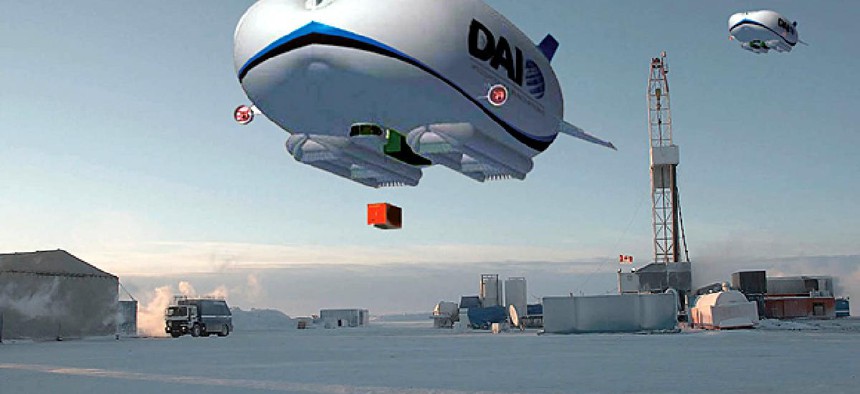Airships could transform Alaska’s transportation system

An artist's concept art for a hybrid airship. Discovery Air Innovations/AP Photo
The vehicles, which carry massive loads, could cheaply supply remote villages.
CORRECTION: This article has been corrected to show Aeros Corp., not Airship Ventures, manufactures aerostats and that the load of the largest Air Force cargo aircraft is 90 tons.
Massive airships could begin operating in Alaska within a decade, and sharply reduce the cost of supplying isolated villages, Lt. Gov. Mead Treadwell told Nextgov by phone prior to the start of a cargo airship conference in Anchorage today.
The conference, sponsored by the NASA Ames Research Center and the University of Alaska, will focus on how airships, which can carry up to 500 tons, could transform Alaska’s commercial transportation system. The Army’s Long Endurance Multi-Intelligence Vehicle, which had its first flight in August, can carry a 2.5-ton sensor package. The largest Air Force cargo aircraft can carry 90 tons.
Treadwell said cargo airships could drastically cut the cost of generator fuel, which needs to be flown in by conventional cargo aircraft to 200 villages not connected to the state’s road system. That boosts the cost of electricity to 40 cents per kilowatt hour, triple the national average of 13 cents per kilowatt hour. Airships also will support movement of heavy supplies for the state's oil, gas and mining industries, which have only a narrow, summer window to use barges to transport large loads before waterways freeze in the fall.
The conference will feature presentations from eight airship companies, including United Kingdom-based Hybrid Air Vehicles, which partnered with North Grumman on the Army Airship, and Ohio Airships of Swanton, Ohio. Both companies will detail plans for cargo airship operations in Alaska and other parts of the Arctic.
Hybrid Air Vehicles plans to develop a cargo airship that can carry up to a 50-ton load and Ohio Airships plans to develop an air freighter that can carry 200 tons. Other airship companies making presentations at the conference include Aeros Corp, which supplies small, unmanned aerostats to the Defense Department; Airship Ventures, Augur Aeronautical Centre Inc., of Russia; ISO Polar, a Canadian airship company; Lockheed Martin Corp.; and Varialift Airships of the UK; and lighter than air (LTA) engineers from SAIC.
NASA Ames, based in Mountain View, Calif., has a partnership with Defense and Aeros to work on heavy airship development, Simon P. “Pete” Worden, the center’s director said. Ames also has a partnership with Airship Ventures for science research. Matt Fladeland, an earth sciences researcher at Ames, said Airship Ventures craft provides a stable and unique platform to sample gases in the atmosphere.
Oleh Maslyukov, an air transport manager for the United Nations World Food Program, will detail that agency’s perspective on the use of airships to deliver food to countries lacking a robust road infrastructure and potentially intercontinental transportation.
Billy Connor, director of the University of Alaska-Fairbanks’ Alaska University Transportation Center, said the conference will address major questions about airships in Alaska, such as: “Are airships economically viable in Alaska? How will they perform in the Arctic? What are the infrastructure needs? And what kind of public-private partnerships are needed to make airships a feasible option for the state,” he said.



